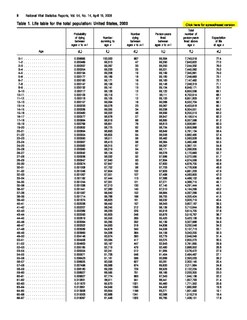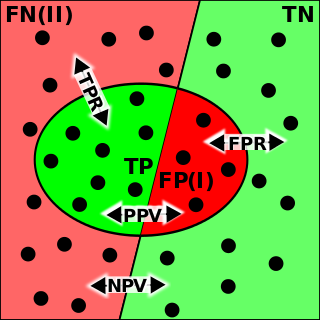Survival analysis is a branch of statistics for analyzing the expected duration of time until one or more events happen, such as death in biological organisms and failure in mechanical systems. This topic is called reliability theory or reliability analysis in engineering, duration analysis or duration modelling in economics, and event history analysis in sociology. Survival analysis attempts to answer questions such as: what is the proportion of a population which will survive past a certain time? Of those that survive, at what rate will they die or fail? Can multiple causes of death or failure be taken into account? How do particular circumstances or characteristics increase or decrease the probability of survival?

In statistics, an interaction may arise when considering the relationship among three or more variables, and describes a situation in which the effect of one causal variable on an outcome depends on the state of a second causal variable. Although commonly thought of in terms of causal relationships, the concept of an interaction can also describe non-causal associations. Interactions are often considered in the context of regression analyses or factorial experiments.
Perioperative mortality has been defined as any death, regardless of cause, occurring within 30 days after surgery in or out of the hospital. Globally, 4.2 million people are estimated to die within 30 days of surgery each year. An important consideration in the decision to perform any surgical procedure is to weigh the benefits against the risks. Anesthesiologists and surgeons employ various methods in assessing whether a patient is in optimal condition from a medical standpoint prior to undertaking surgery, and various statistical tools are available. ASA score is the most well known of these.

In actuarial science and demography, a life table is a table which shows, for each age, what the probability is that a person of that age will die before his or her next birthday. In other words, it represents the survivorship of people from a certain population. They can also be explained as a long-term mathematical way to measure a population's longevity. Tables have been created by demographers including Graunt, Reed and Merrell, Keyfitz, and Greville.
In the United Kingdom, junior doctors are qualified medical practitioners working whilst engaged in postgraduate training. The period of being a junior doctor starts when they qualify as a medical practitioner following graduation with a Bachelor of Medicine, Bachelor of Surgery degree and start the UK Foundation Programme, it culminates in a post as a Consultant, a General Practitioner (GP), or some other non-training post, such as a Staff grade or Associate Specialist post.
Predictive modelling uses statistics to predict outcomes. Most often the event one wants to predict is in the future, but predictive modelling can be applied to any type of unknown event, regardless of when it occurred. For example, predictive models are often used to detect crimes and identify suspects, after the crime has taken place.
In epidemiology and demography, age adjustment, also called age standardization, is a technique used to allow populations to be compared when the age profiles of the populations are quite different.
A virtual ward is a cadre for providing support in the community to people with the most complex medical and social needs. The concept was developed in Croydon Primary Care Trust – and virtual wards are now being introduced in several parts of the UK. Virtual wards use the systems and staffing of a hospital ward, but without the physical building: they provide preventative care for people in their own homes. The project won in four categories of the 2006 Health Service Journal Awards namely Primary Care Innovation, Patient-Centred Care, Information-Based Decision Making, and Clinical Service Redesign. This was the first time in the 25-year history of the HSJ awards that a project won in four categories. In 2007 it won the Transformation category of the Public Service Awards run by The Guardian and was judged overall winner of those awards.
In epidemiology, the standardized mortality ratio or SMR, is a quantity, expressed as either a ratio or percentage quantifying the increase or decrease in mortality of a study cohort with respect to the general population.

South Central Ambulance Service NHS Foundation Trust (SCAS) is the ambulance service for the counties of Buckinghamshire, Oxfordshire, Berkshire and Hampshire. It is a foundation trust of the National Health Service, and one of 10 NHS ambulance trusts in England.

Operating room management is the science of how to run an Operating Room Suite. Operational operating room management focuses on maximizing operational efficiency at the facility, i.e. to maximize the number of surgical cases that can be done on a given day while minimizing the required resources and related costs. For example, what is the number of required anaesthetists or the scrub nurses that are needed next week to accommodate the expected workload or how can we minimize the cost of drugs used in the Operating Room? Strategic operating room management deals with long-term decision-making. For example, is it profitable to add two additional rooms to the existing facility? Typically, operating room management in profit-oriented health-care systems emphasizes strategic thinking whereas in countries with publicly funded health care, the focus is on operational decisions.

The National Health Service (NHS) is the publicly funded national healthcare system for England and one of the four National Health Services for each constituent country of the United Kingdom. It is the largest single-payer healthcare system in the world. (Important to note that the single payer term means something a little different to the phrase used widely in the USA. The English NHS is both Payer and Provider of healthcare.. Primarily funded through the government funding and overseen by the Department of Health, NHS England provides healthcare to all legal English residents, with most services free at the point of use. Some services, such as emergency treatment and treatment of infectious diseases, are free for everyone, including visitors.
Aintree University Hospital NHS Foundation Trust is an NHS Foundation Trust located in the suburb of Fazakerley, in the city of Liverpool, England. It was formerly known as University Hospital Aintree NHS Trust and became a Foundation Trust in 2006. It manages Aintree University Hospital.
United Lincolnshire Hospitals NHS Trust runs County Hospital Louth, Lincolnshire, John Coupland Hospital in Gainsborough, Lincolnshire, Lincoln County Hospital, Pilgrim Hospital in Boston, Skegness & District Hospital, and Grantham and District Hospital
Mid Cheshire Hospitals NHS Foundation Trust is an acute hospital trust in Cheshire. It runs Leighton Hospital in Crewe, Victorria Infirmary in Northwich and Elmhurst Intermediate Care Centre in Winsford.
The Trauma Quality Improvement Program (TQIP) was initiated in 2008 by the American College of Surgeons Committee on Trauma. Its aim is to provide risk-adjusted data for the purpose of reducing variability in adult trauma outcomes and offering best practice guidelines to improve trauma care. TQIP makes use of national data to allows hospitals to objectively evaluate their trauma centers' performance relative to other hospitals. TQIP's administrative costs are less than those of other programs, making it an accessible tool for assessing performance and enhancing quality of trauma care.

The evaluation of binary classifiers compares two methods of assigning a binary attribute, one of which is usually a standard method and the other is being investigated. There are many metrics that can be used to measure the performance of a classifier or predictor; different fields have different preferences for specific metrics due to different goals. For example, in medicine sensitivity and specificity are often used, while in computer science precision and recall are preferred. An important distinction is between metrics that are independent on the prevalence, and metrics that depend on the prevalence – both types are useful, but they have very different properties.
In healthcare, the weekend effect is the finding of a difference in mortality rate for patients admitted to hospital for treatment at the weekend compared to those admitted on a weekday. The effects of the weekend on patient outcomes has been a concern since the late 1970s, and a ‘weekend effect’ is now well documented. Although this is a controversial area, the balance of opinion is that the weekend have a deleterious effect on patient care —based on the larger studies that have been carried out. Variations in the outcomes for patients treated for many acute and chronic conditions have been studied.

The Robert Jones and Agnes Hunt Orthopaedic Hospital (RJAH) in Oswestry, Shropshire, England is a specialist orthopaedic hospital which provides elective orthopaedic surgery. It is managed by the Robert Jones and Agnes Hunt Orthopaedic Hospital NHS Foundation Trust.
MELD-Plus is a risk score to assess severity of chronic liver disease. The score includes nine variables as effective predictors for 90-day mortality after a discharge from a cirrhosis-related admission. The variables include all Model for End-Stage Liver Disease (MELD)'s components, as well as sodium, albumin, total cholesterol, white blood cell count, age, and length of stay. MELD-Plus was created as a result of a collaboration between Massachusetts General Hospital and IBM.









